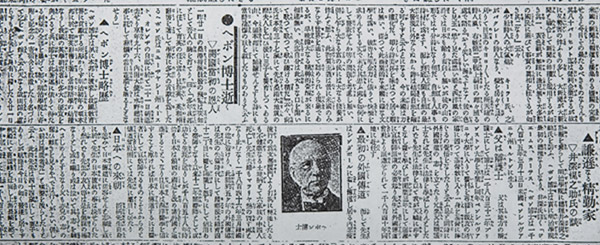The passing of Dr. Hepburn;the article in the Tokyo Asahi Shimbun on September 24, 1911(Meiji 44)

Extracts from the obituary A Modest, Industrious Man by the Second Master of Meiji Gakuin University, Ibuka Kajinosuke
"The work done by the Doctor in Japan can be divided into two parts. The first being the Western medical work
upon which he focused in Yokohama. While Japanese-Dutch medicine existed in Nagasaki in the past, it was nowhere
to be found in Yokohama. Taking the post as a medic, the Doctor took medical doctor Miyake Hiizu on as a
student, as well as taking the future Minister of Communications Hayashi Tadasu under his wing from the age of
13 to 17 Moreover the Doctor established a free clinic in 1861, and while the Tokugawa government forbade its
use, his skills gradually became known among the Japanese people. After the then famous actor Sawamura Tanosuke
had his leg amputated and received medical treatment, the phrase ‘something even Hepburn cannot cure' entered
the vernacular, and he became as respected as a deity. Nevertheless, around the 10th year of Meiji, once it
became possible for his many successors to practice Western medicine, the Doctor was no longer required to
practice medicine, he resolved to leave it behind and focus solely on compiling a dictionary and translating The
Bible. Hepburn's Japanese-English dictionary, which later became famous, was published in its first edition in
Shanghai in 1867, and was peerless in the extent to which it was esteemed by contemporary Western scholars. At
around the time of the 5t or h6th year of Meiji, one volume cost 50 yen. Before the so-called Hepburn's
dictionary, there was the Satsuma Dictionary, but this was far less complete than Hepburn's."
"The endeavor to translate the New Testament into Japanese was undertaken with the collaboration of the three
doctors Hepburn, Brown, and Green, who later compiled a dictionary to The Bible. Hepburn's wife provided advice
and was a wise woman. She was to become the founder of Japan's first women's college: Ferris Jogakuin in Foreign
Settlement No.1 78 in Yamate, Yokohama. The Doctor remained in Japan for 33 years, returning with his wife to
their home country in October of the 25th year of Meiji at the age of 77, where they settled in East Orange, New
Jersey to enjoy the rest of their days. I visited the Doctor in the summer of last year, which was to be the
last time I met him. The Doctor humble, dedicated, and industrious. His foresight in terms of the introduction
of Western medicine into Japan, the compilation of the dictionary, and the propagation of Christianity was
recognized. He was decorated with the Third Order of the Rising Sun in the 38th year of Meiji. The doctor wore
this around his neck when attending a graduation ceremony at Princeton University, his alma mater, winning
unbroken applause from those around him..."
From an obituary titled Alas, Dr. Hepburn by the Governor of the Bank of Japan, Takahashi Korekiyo:
"Alas, Dr. Hepburn has passed away. Last year I visited him in his lonely residence in New Jersey after his
now-deceased wife fell ill in New York and was hospitalized; he has finally bid adieu to this
world."
"It was the 1st year of Keio when I left for Yokohama and passed through the gates of the Doctor as a boy of 11
or 12. At the time, the Doctor's main profession was as a missionary. At what are now the station grounds but
was then a church, he did eye surgery alongside the missionary work. The now deceased Kishida Ginko taught the
Doctor study of Chinese classics and worked as his assistant. The eye drops known as Kishida Seikisui enjoyed
great popularity once upon a time; Mr. Kishida was in the future to sell these eye drops used by the Doctor.
Unlike the missionaries of today, the Doctor did not boast in his explanations of Christianity or of his many
believers; he explained the technologies of the Occident to the Japanese people and worked solely to widen the
horizons of culture. A man of noble character, his behavior was a lesson in how to live."
"The Doctor attained the help of Mr. Kishida in compiling an English-Japanese and Japanese-English dictionary,
which was then published in Shanghai and proved to be a great convenience for Japanese people engaged in the
learning of English. The dictionary was known as ‘Hepburn's Dictionary,' and was a highly esteemed work. This
was probably the beginning of English dictionaries for Japan."
"Around the time of the 7th or 8th year of Meiji, the Ministry of Education received a proposal from Mr. Murray,
who was sympathetic to the request for assistance by Dr. Hepburn during this time in regards to obtaining
copyright protection for the republication of his dictionary. At this time, there were of course no regulations
in place in Japan in regards to publications or patents, and frankly the necessity or lack of necessity of
enacting such protection had not been discussed. At this point I was instructed by the Government to conduct a
survey, but with no reference volume in either the Ministry of Education or the library, I was forced to rely on
the Encyclopedia Britannica to just about understand the nature of the word. A funny surprise was that I later
enacted an edict regarding patents, having transferred to the Ministry of Agriculture and Commerce, another
story that has its origins with Dr. Hepburn."
